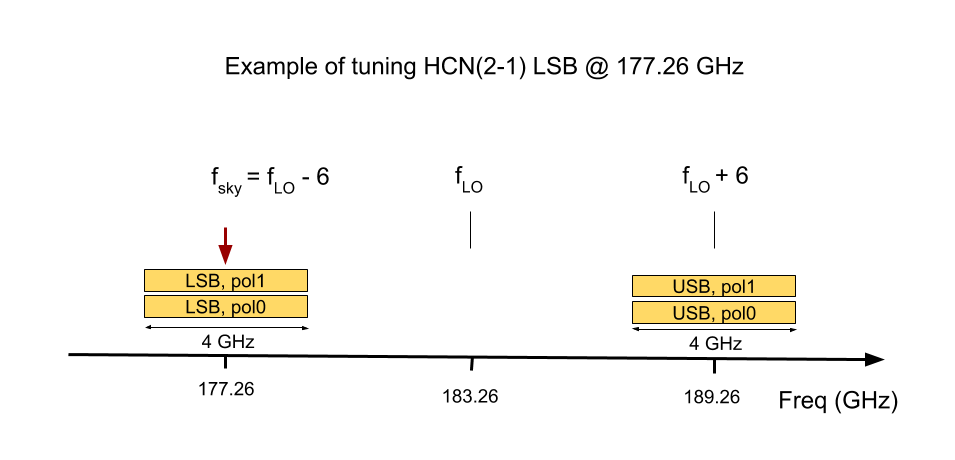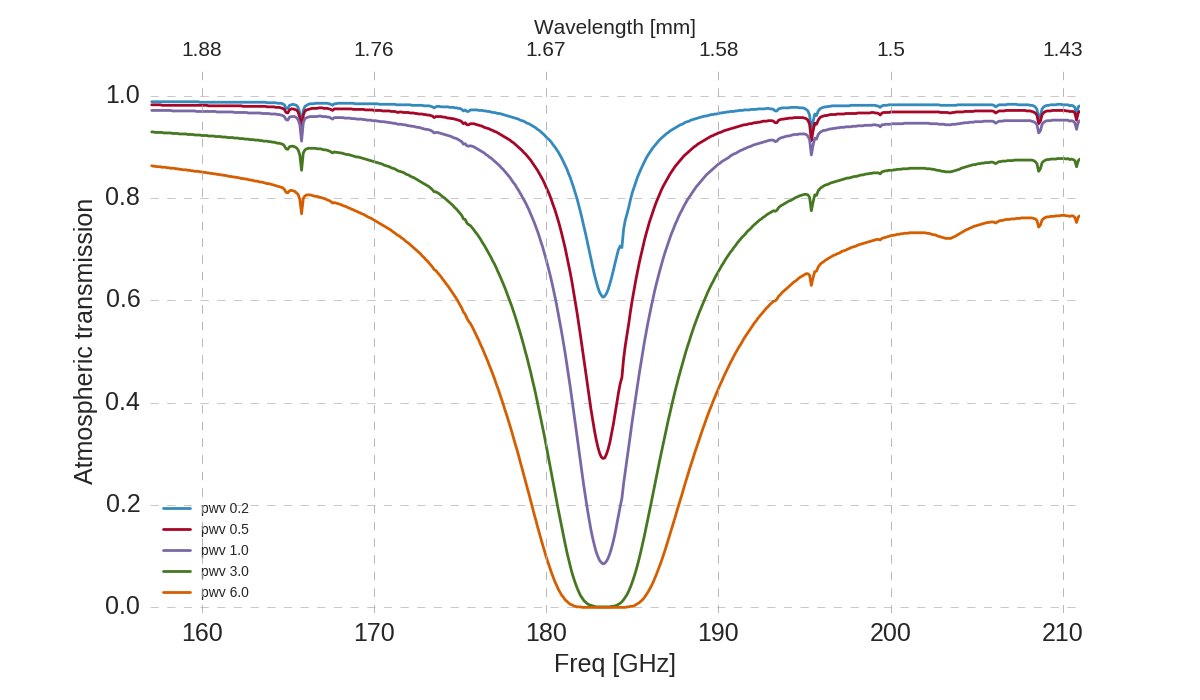Technical details
The SEPIA180 channel is a dual polarisation 2SB receiver built to the specifications of ALMA Band 5 (it is based on the pre-production version of such receiver). The instrument was built by the Group for Advanced Receiver Development (GARD) at Onsala Space Observatory (OSO) in Sweden
The SEPIA180 receiver has two IF outputs per polarisation, USB and LSB, each covering 4-8 GHz, adding up a total of 16 GHz instantaneous IF bandwidth. The central frequencies of the two sidebands are separated by 12 GHz. In the next figure you can see an example of instrument configuration when tuned to an astronomical line in the LSB (lower sideband).

The sideband rejection ratio is by design >10 dB and 18.5 dB on average. The single-sideband noise temperature is below 55K at all frequencies within the RF band. The HPBW of APEX at the SEPIA180 frequencies is in the range 30-39 arcsec. More details about the instrument can be found in the technical paper of the instrument.
SEPIA180 atmospheric window
At the moment, SEPIA180 covers the lowest frequency window available with APEX. It enables observations within the frequency range 159-211 GHz, which includes the 183 GHz water vapour line. Observing this transition in the ISM is one of the scientific motivations for the usage of this instrument, but it is also extremely difficult due to the strong absorption by the water vapour present in the Earth’s atmosphere. Extremely dry places like the Chajnantor plateau are unique to perform these challenging observations.

In the figure above the atmospheric transmission in the SEPIA180 frequency range (159 – 211 GHz) is shown. At the Chajnantor Plateau the transmission at 183 GHz is better than 0.3 if pwv < 0.5 mm. In 2012 this happened about 15% of the total time when the pwv was measured. This means that at Chajnantor, the 183 GHz water line is accessible for Galactic observations for some 50 days every year. Naturally, outside the water line, at frequencies below 174 GHz or above 192 GHz, the atmospheric transmission is similar to that in the 3-mm window, basically close to 100% transmission for most weather conditions.
Despite the water line just mentioned, the J = 2–1 transitions of the nitrogen-bearing species HCN, HNC, and N2H+ as well as HCO+ are available in the SEPIA180 frequency range. Their isotopologues H13CN, HC15N, H13CO+ and HC18O+ are observable in one frequency setting as are HCN and HCO+. These transitions serve as low-energy complements to the higher J-lines which are covered by other APEX bands, probing material that is colder and of lower density.
Observing with SEPIA180
SEPIA180 is a PI receiver delivered by ESO/OSO, but it is open to any PI through all the APEX partner queues.
Publications using data obtained with the SEPIA180 receiver shall refer to the instrument papers:
Belitsky, V.; Lapkin, I.; Fredrixon, M.; Meledin, D.; Sundin, E.; Billade, B.; Ferm, S. -E.; Pavolotsky, A.; Rashid, H.; Strandberg, M.; Desmaris, V.; Ermakov, A.; Krause, S.; Olberg, M.; Aghdam, P.; Shafiee, S.; Bergman, P.; De Beck, E.; Olofsson, H.; Conway, J. De Breuck, C.; Immer, K.; Yagoubov, P.; Montenegro-Montes, F. M.; Torstensson, K.; Pérez-Beaupuits, J. -P.; Klein, T.; Boland, W.; Baryshev, A. M.; Hesper, R.; Barkhof, J.; Adema, J.; Bekema, M. E.; Koops, A. SEPIA – a new single pixel receiver at the APEX telescope Astronomy & Astrophysics, (2018) Volume 612, A23, (12 pages).Belitsky, V.; Bylund, M.; Desmaris, V.; Ermakov, A.; Ferm, S. -E.; Fredrixon, M.; Krause, S.; Lapkin, I.; Meledin, D.; Pavolotsky, A.; Rashid, H.; Shafiee, S.; Strandberg, M.; Sundin, E.; Yadranjee Aghdam, P.; Hesper, R.; Barkhof, J.; Bekema, M. E.; Adema, J.; de Haan, R.Koops, A.; Boland, W.; Yagoubov, P.; Marconi, G.; Siringo, G.; Humphreys, E.; Tan, G. H.; Laing, R.; Testi, L.; Mroczkowski, T.; Wild, W.; Saini, K. S.; Bryerton, E., ALMA Band 5 receiver cartridge. Design, performance, and commissioning, Astronomy & Astrophysics, (2018), Volume 611, A98 (10 pages)